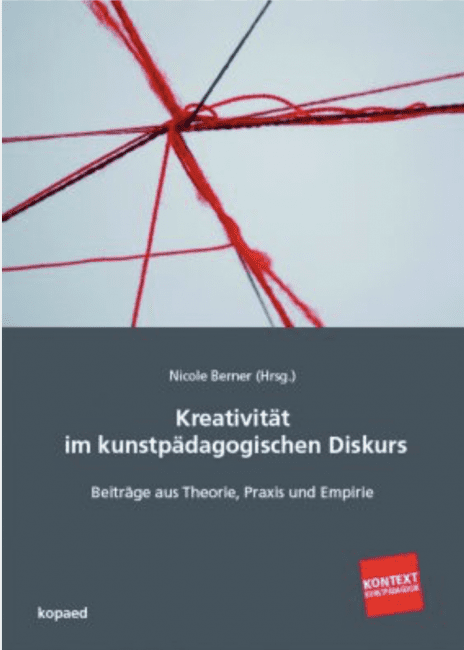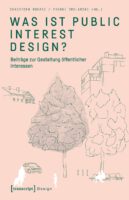
Cover Creativity in art education discourse kopaed 2018
Introduction
Like all primates, humans also have an innate creative potential. Our creative intelligence always comes to the fore when we use improvisation and reflection to devise solution strategies for new challenges. We need knowledge, methods and practical experience to develop creative skills and abilities that we can use in a targeted manner to overcome the diverse challenges of modern societies. Creativity is the basis of research and innovation. Creativity education promotes personal development and enables all individuals to help shape the future of modern societies. One indicator of this is the growing importance of the cultural and creative industries, which are already making a significant contribution to value creation in our society. My article shows ways to systematically promote creativity. The focus here is on creating a framework in which the creative potential of all individuals can develop optimally. Teachers become initiators, moderators and critics of creative processes, the results of which offer them a wealth of possibilities for stimulating processes of understanding and deriving individually effective methods.
1. creativity as a factor in personal development
People use the innate creative and analytical potential of their brains to interact with their living environment in equal measure. Creative achievements are advantageous and often even vital when living beings are confronted with new problems and effective strategies for action are unknown. Analytical performance is helpful when problem-solving strategies can be derived from recurring successful patterns of action. These innate learning and action strategies for problem solving can be observed not only in humans. Both the acquisition of action routines and the ability to improvise are evolutionary strategies that ensure the survival of many living beings in complex environments (May 1988). Creativity and rationality, on the other hand, are culturally formed competencies that drive progress in science, art and technology in addition to personal development (Sawyer 2012). Creative and rational strategies for finding ideas and solving problems are therefore equally key skills for the successful participation of individuals in modern societies (Buether 2016). The systematic education of creativity serves to develop the personality and is intended to promote an open, curious and exploratory attitude towards the environment and to convey creative thinking and action strategies. The basis for this is an artistic practice from which the ability to reflect on creative processes and the knowledge and skills to apply effective methods can be developed (Buether 2013). In practice, creative freedom is always dependent on phases of intellectual reflection and systematic analysis. Ideas must be regularly submitted for criticism in order to: a) recognize their significance, b) understand their meaning, c) to recognize possible development potential, d) evaluate their qualities, e) select particularly concise variants, f) test prototypes and g) make well-founded decisions.
Innovation is only possible when tried and tested strategies of thought and action are abandoned, unknown paths are taken, fantasies are allowed, utopian goals are set and failure is accepted. The intended, methodical promotion of creativity strengthens the positive basic attitude of individuals towards society, which offers each new generation a free space for their own experiences, inquisitive research efforts and creative transformations. Creativity is an imaginative method of appropriating the world, the basis for playful-experimental learning and a prerequisite for the development of an independent creative position.
2. creativity as a factor in social progress
The methodical promotion of creativity not only serves to develop personality and cope with life, but also has enormous social benefits. The constantly growing fields of the cultural and creative industries form the fastest growing sector of the global economy. Creativity is one of the central key skills in almost all professional fields today, as many solutions to problems cannot be found using analytical methods alone. Every individual must learn to critically scrutinize facts and routines, to pursue unfamiliar solutions with the risk of failure and to assert the positions they have found in discursive processes. We need new solutions for the unsolved problems of the present, innovative products and creative people in all future-relevant professional fields, especially in the STEM qualifications (science, technology, engineering and mathematics). Every human being is creative, but similar to logical thinking abilities, creative potential can only unfold through explicit encouragement (Hüther & Hauser 2012). The methodical promotion of the core competence of creativity should therefore be developed into a central task of art didactics. Creativity techniques and methods of their application could then be taught both subject-specifically and interdisciplinary in their significance for art, language and science.
The cultural and creative industries currently make a significant contribution to the overall economy of modern societies. This growth will continue to accelerate as a result of the ongoing digitalization of all areas of life and work. In Germany alone, more than 250,000 companies employing around 1.6 million people generate more than 150 billion euros in revenue from the creative design of cultural spaces (Federal Ministry for Economic Affairs and Energy, 2016). The gross value added of the cultural and creative industries is therefore already higher than the figures for the chemical and energy industries. It is approaching the economic importance of mechanical engineering and the automotive industry (Federal Ministry for Economic Affairs and Energy, 2016). The cultural and creative industries are made up of various core areas whose employment figures are subject to varying degrees of dynamic development. Led by the software/games industry, the press and advertising market and the design industry, the architecture market, the book market, the film industry and the music industry follow in midfield. The broadcasting industry, the performing arts market and the art market follow at the bottom of the table (Federal Ministry for Economic Affairs and Energy, 2016). The figures for the cultural and creative industries do not even include the creative minds in industry who, together with the scientific and technological specialists, make the global success of modern products and services possible. Creativity is a key competence in the search for and research into sustainable, healthy and environmentally friendly products, production methods, buildings, infrastructures, communication technologies and services. Only through innovation in all areas of our living and working environment will we master the challenges of the future. Art lessons can teach adolescents a critical and constructive attitude towards the effects of global consumer mechanisms. A discourse can show how we can use our creativity to use the world’s limited resources responsibly. Design thinking and design ethics belong together when creative strategies are taught in art lessons, even if the latter is still an almost undiscovered field of research in Germany (Buether, 2016).
3. didactics of creativity
By creating important framework conditions and methodically promoting key emotional and cognitive factors, teachers can have a targeted effect on the creative performance of all learners and initiate creative processes (Buether, 2013). In the following, ten points for the methodical promotion of creativity are presented in more detail, from which teachers can develop their own didactics of creativity (see Box 1). Like any art of teaching, this cannot be acquired by studying content and methods alone, but only by testing and evaluating theory in project practice. Teachers must ensure that teaching units to promote creativity have an open, exploratory-experimental and discursive-critical character. Exercises to promote creativity in the classroom should stimulate the imagination and develop meaning for the present and future of all learners.
Tasks must be clearly structured in terms of content, time and method and formulated in a simple and understandable way. While goals must be precisely defined, solutions should remain free and results open. The quality of a task to promote creativity is reflected in the diversity of solutions and results. Collective work on creative tasks is beneficial if all group members make an independent creative contribution to the overall result. The tasks of teachers begin with creating the conditions in which creativity can unfold. They lead to the supervision of research, experimental and critical-discursive processes in which creativity can take place and extend to assessment and evaluation. The value of a creativity exercise is demonstrated by the innovative power of the idea, which can be seen both in the course of the process and in the work.
The following questions, which can be supplemented accordingly, provide important criteria for the evaluation of exercises to promote creativity:
a) How interesting are the questions that the learners ask themselves and others at the start of the project, during the course of the project or at the end of the project?
b) Is an independent aesthetic or scientific research approach recognizable and with what risk and what consistency was it pursued?
c) Were there any aesthetic, media or technical inventions in the course of the project and what value did they have for the development of the idea?
d) What challenges does the work present in terms of aesthetic (perception), technical (production) and media (communication) issues?
The quality and power of innovations can be assessed either in absolute or subject-related terms. Absolute evaluations of innovations can be found in the fields of art and science, where the uniqueness of findings, practices and works gives rise to a claim to authorship. In the field of education, on the other hand, the assessment of the innovative content must be subject-related and set against the context of the learning situation. What is new and innovative for learners can be justified solely on the basis of learning success, whereby the entire course of the project must be taken into account. The creative process should therefore be documented from the beginning to the finished work in a sketchbook, which should contain sketches of ideas and illustrations of the entire work process as well as questions, criticism and answers.
10 points for the methodical promotion of creative processes
1. leisure – create space for playful-experimental situations
2. working atmosphere – create or search for thematically stimulating contexts
3. feeling of pleasure – finding an emotionally motivating attitude to the topic
4. interest – finding a mentally motivating perspective on the topic
5. reflection – perception and evaluation of the course of the process
6. flow of ideas – make the path your destination and go on a journey of discovery
7. synergies – participatory learning and autonomous thinking in discourse
8. inspiration – seeking socio-cultural and interdisciplinary exchange
9. improvisation – cultivating spontaneity and gut feeling on the fly
10. originality – focus on the search for ideas and personality development
full book contribution in:
Creativity in art education discourse
Nicole Berner (ed.)
kopaed Verlag ISBN 978-3-86736-147-7
Publication series Kontext Kunstpädagogik
Volume 47, Munich 2018, 301 pages


